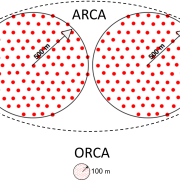Yet another virtual spring meeting
A few weeks ago, KM3NeT held its two-week long spring meeting, once again virtually, like almost all meetings nowadays.
A few weeks ago, KM3NeT held its two-week long spring meeting, once again virtually, like almost all meetings nowadays.
05 May 2021 – The potential of KM3NeT to measure key properties of neutrinos – in March 2021, the KM3NeT Collaboration released a publication showing that KM3NeT with its ORCA detector will be in an excellent position to study the phenomenon of neutrino oscillations!
8 March 2019 – Last month, the KM3NeT team of CPPM, Marseille together with the ship crews successfully installed an ORCA detection unit. It was the first unit connected to the refurbished main electro-optical cable to shore. After a few weeks of technology tests, the unit is given free for physics runs. ORCA is operational! Read more
On 22 September 2017, after a two day long sea operation, the first detection unit of the ORCA neutrino telescope came online. This marks an important milestone of the scientific and technological endeavour of the international KM3NeT Collaboration.
22 July 2016 – The KM3NeT Collaboration congratulates Simon Bourret, Astroparticle and Cosmology, Paris with the award of one of the Best Poster Prizes for his poster presented at the International ISAPP Summer Institute, 11-21 July in L’Aquila, Italy.
12 July 2016 – The KM3NeT Collaboration congratulates João Coelho, Astroparticle and Cosmology, Paris with the award of one of the Nature Poster Prizes at the Neutrino 2016 conference, 4-9 July in London. Read more
 10 May 2015: KM3NeT has defined the next step in the realisation of the research infrastructure in the deep seas of the Mediterranean: KM3NeT2.0 to conduct Astroparticle & Oscillations Resreach with Cosmics in the Abyss with ARCA and ORCA.More in the KM3NeT-Strategy Report 2015-05-06.
10 May 2015: KM3NeT has defined the next step in the realisation of the research infrastructure in the deep seas of the Mediterranean: KM3NeT2.0 to conduct Astroparticle & Oscillations Resreach with Cosmics in the Abyss with ARCA and ORCA.More in the KM3NeT-Strategy Report 2015-05-06.